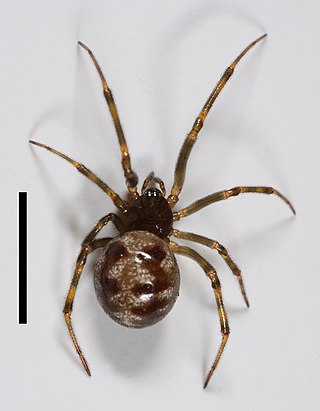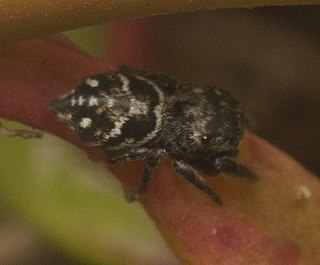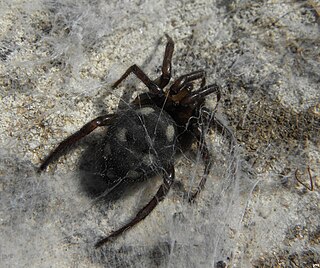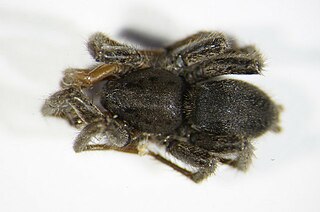
Latrodectus is a broadly distributed genus of spiders with several species that are commonly known as the true widows. This group is composed of those often loosely called black widow spiders, brown widow spiders, and similar spiders. However, the diversity of species is much greater. A member of the family Theridiidae, this genus contains 34 species, which include several North American "black widows". Besides these, North America also has the red widow Latrodectus bishopi and the brown widow Latrodectus geometricus, which, in addition to North America, has a much wider geographic distribution. Elsewhere, others include the European black widow, the Australian redback spider and the closely related New Zealand katipō, several different species in Southern Africa that can be called button spiders, and the South American black-widow spiders. Species vary widely in size. In most cases, the females are dark-coloured and can be readily identified by reddish markings on the central underside (ventral) abdomen, which are often hourglass-shaped.

Spitting spiders are a family of araneomorph spiders, the family Scytodidae, first described by John Blackwall in 1864. It contains over 250 species in five genera, of which Scytodes is the best-known.

Octavius Pickard-Cambridge FRS was an English clergyman and zoologist. He was a keen arachnologist who described and named more than 900 species of spider from a large collection that he made with contributions sent to him by correspondents from around the world.

The spider genus Steatoda, in the family Theridiidae, includes about 120 recognized species, distributed around the world. One common name is cupboard spider, for many species build their webs in dark, sheltered, undisturbed places around the house or garden, in sheds and garages, under garden, in compost bins, and the like. Signs of the cupboard spider include small white spots of spider droppings, like small splashes of paint, on the floor underneath the web.

Steatoda grossa, commonly known as the cupboard spider, the dark comb-footed spider, the brown house spider, or the false widow or false black widow, is a common species of spider in the genus Steatoda.

The triangulate cobweb spider is a common spider in the genus Steatoda. It is well known for the triangle-shaped pattern on the dorsal side of its abdomen.

Steatoda nobilis is a spider in the genus Steatoda, known in the United Kingdom as the noble false widow, as it superficially resembles and is frequently mistaken for the black widow and other spiders in the genus Latrodectus. It is often referred to as thefalse widow, although "false widow" is a more general term applied to a wider group of species with this resemblance.[a] It is a moderately medically significant spider, with most bites resulting in symptoms similar to a bee or wasp sting. Some bites may cause more significant harm, partly due to pathogenic bacteria from the spiders.

Bianor is a genus of boreal jumping spiders that can grow to 3 and 4 mm. The robust shiny body and northerly distribution are distinctive. Males can be easily recognized by his swollen forelegs and females have orange legs. It was first described by George and Elizabeth Peckham in 1886, who presumably named it after the mythical character Bianor (=Ocnus).

Neon is a spider genus of the jumping spider family, Salticidae. Its described species occur mostly in Eurasia, with some species found in North and South America. One species, N. convolutus, is also found in Algeria. Two species are known from Australia, N. australis and N. taylori. N. australis has palp morphology and fringing on its first pair of legs very similar to that seen in N. nojimai Ikeda 1995, from Japan. N. taylori is most similar in morphology to N. sumatranus from Indonesia and N. kovblyuki from the Crimea and elsewhere. The genus is common and widespread in litter throughout Australia, from the highlands of Tasmania through the hot, dry inland to the wet tropics and includes many undescribed species.

Latrodectus cinctus is a species of spider in the family Theridiidae, found in Cape Verde Islands, Africa, Kuwait and Iran. It is one of six species of Latrodectus found in southern Africa, four of which, including L. cinctus, are known as black button or black widow spiders. Like all Latrodectus species, L. cinctus has a neurotoxic venom. It acts on nerve endings, causing the very unpleasant symptoms of latrodectism when humans are bitten.

Uroctea is a genus of spiders that is found in Eurasia and Africa. It is sometimes put into its own family, Urocteidae. Their tent-like web is very similar to the ones Oecobius builds; but Uroctea species do not have a cribellum.

Hersiliola is a genus of tree trunk spiders that was first described by Tamerlan Thorell in 1870.
Pycnacantha is a genus of African orb-weaver spiders first described by John Blackwall in 1865.

Berlandina is a genus of ground spiders that was first described by Raymond de Dalmas in 1922.

Paidiscura is a genus of comb-footed spiders that was first described by Allan Frost Archer in 1950.
Steatoda fallax is a species of spiders of the family Theridiidae that is endemic in Cape Verde. The species was first described as Theridion fallax by John Blackwall in 1865.
Hersiliola versicolor is a species of spiders of the family Hersiliidae that lives in Cape Verde. It was first described by John Blackwall in 1865 as Hersilia versicolor. The females have a total length of 3.75-4.58 mm.

Kochiura aulica is a species of spiders in the family Theridiidae. It is found on the Canary Islands, Cape Verde Islands to Azerbaijan.














